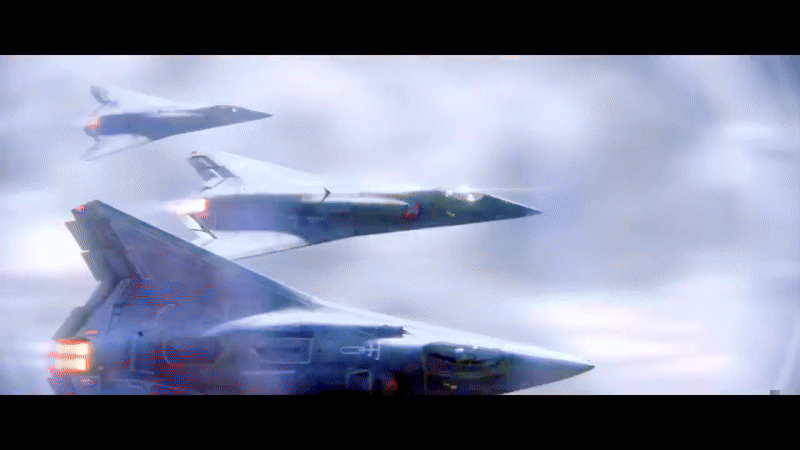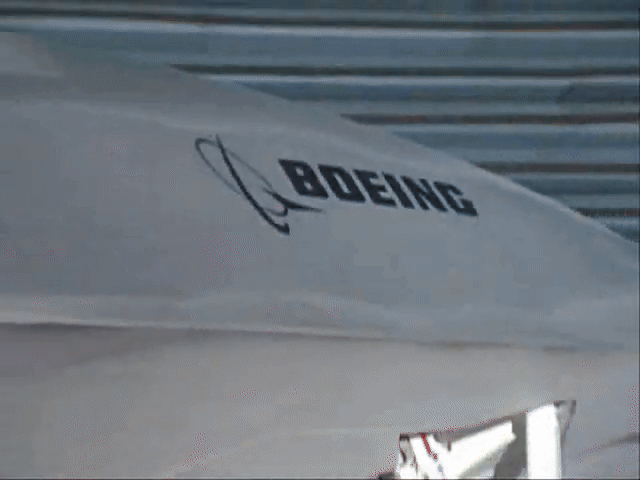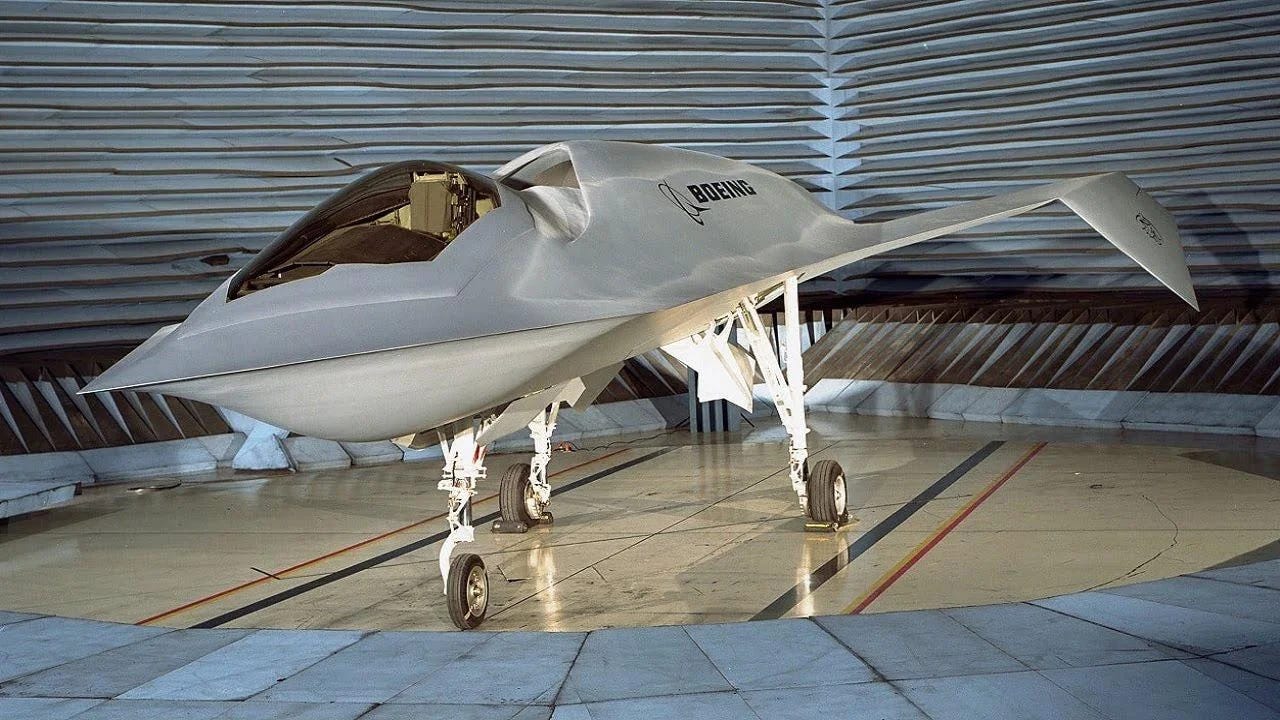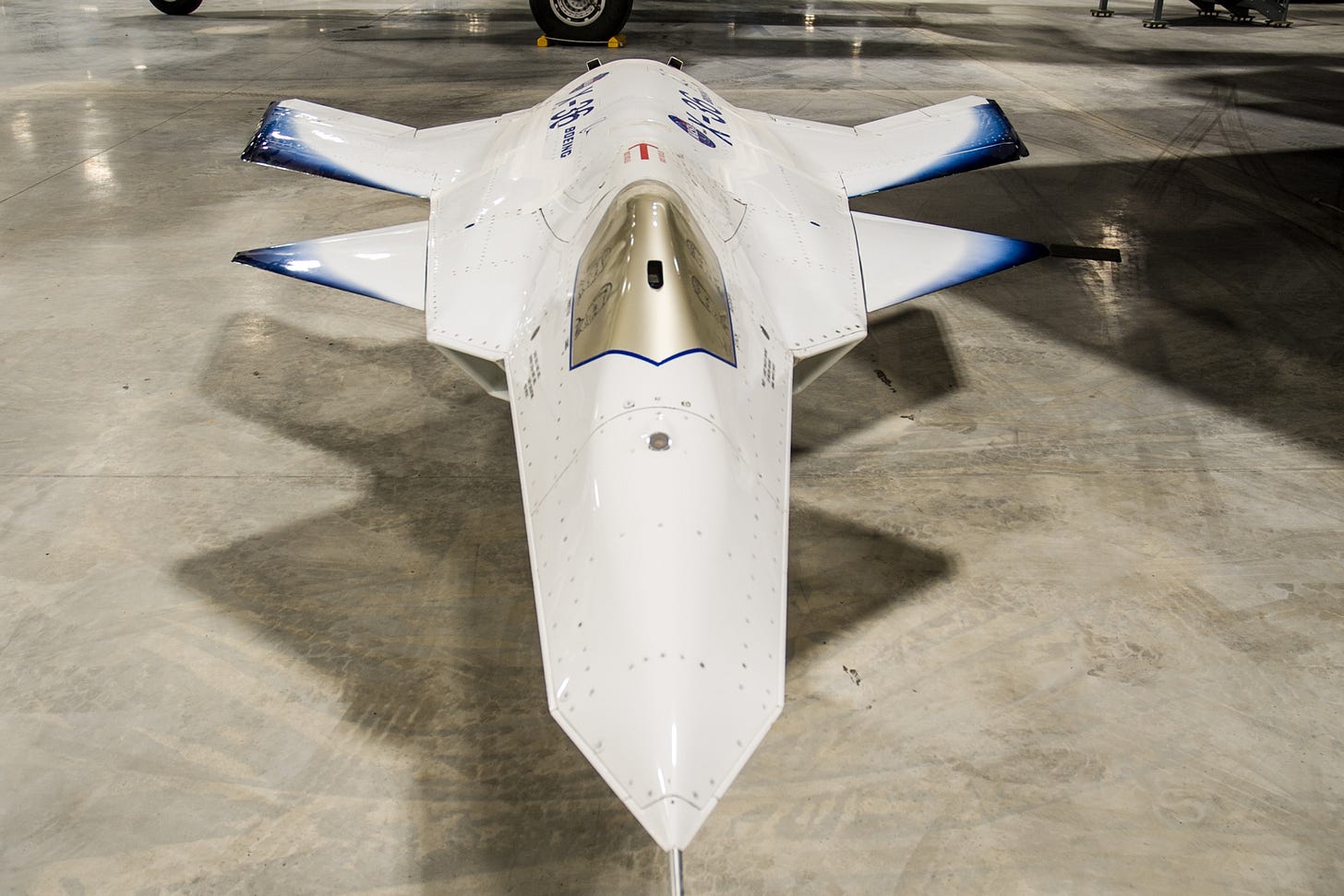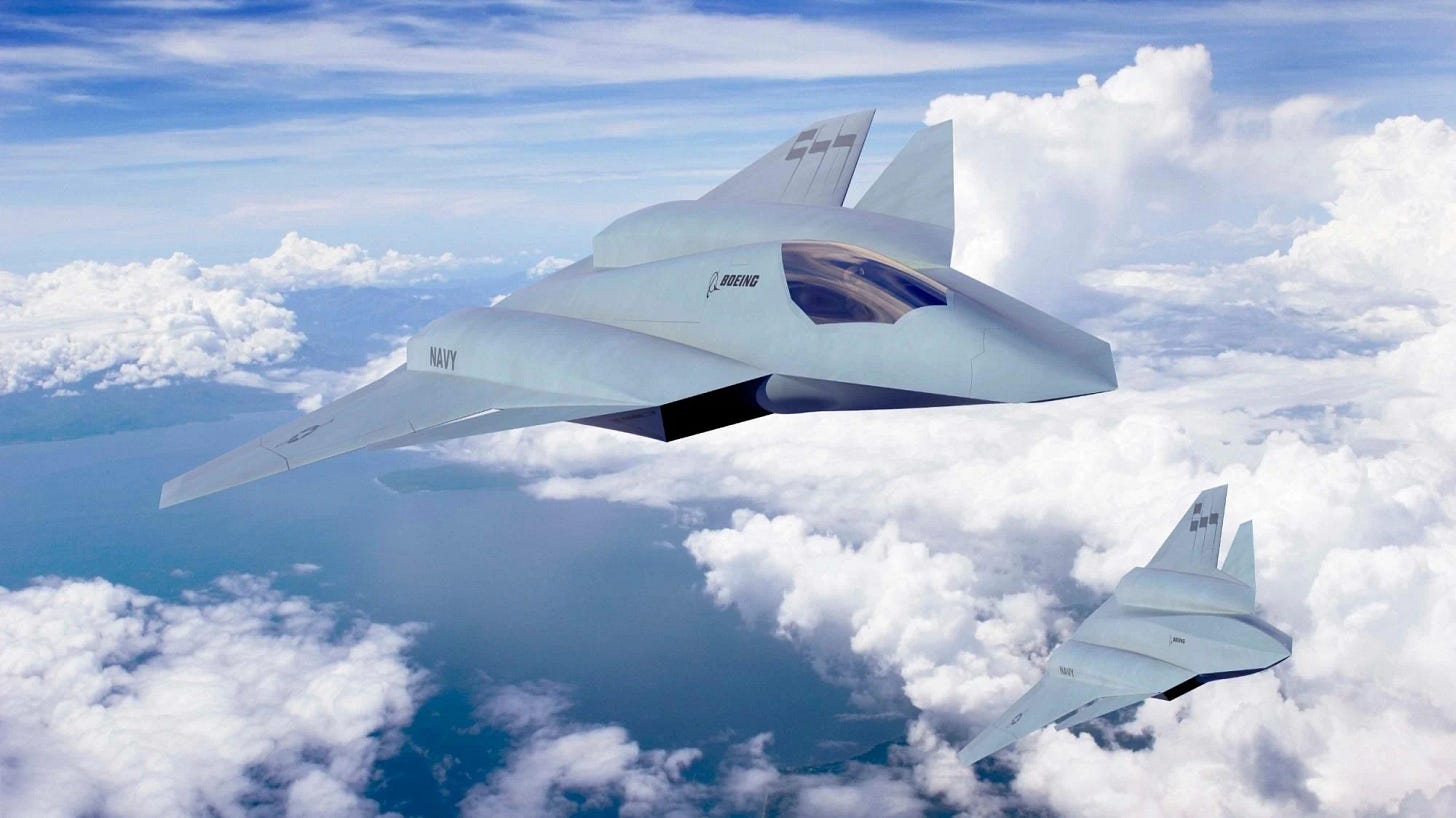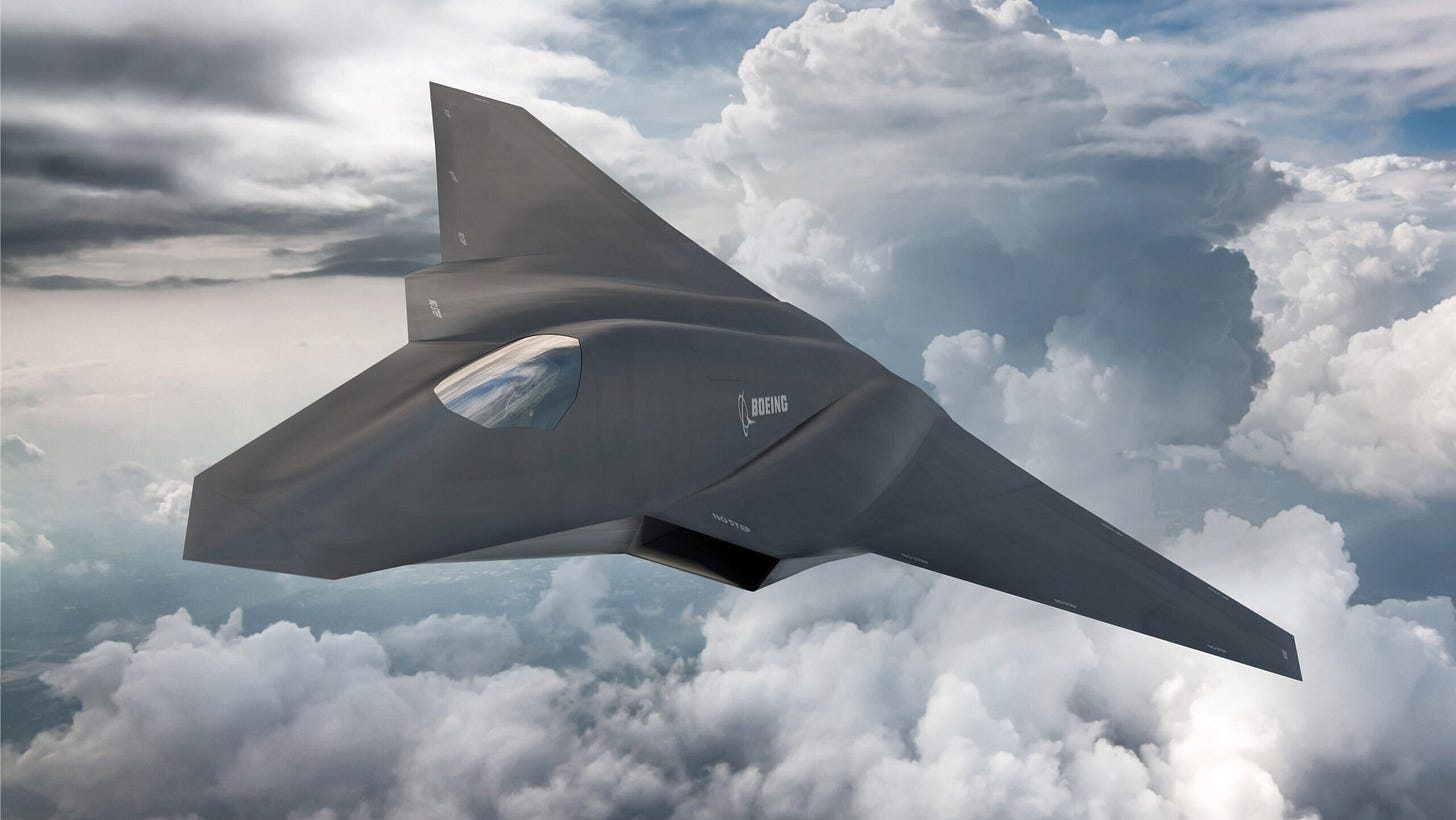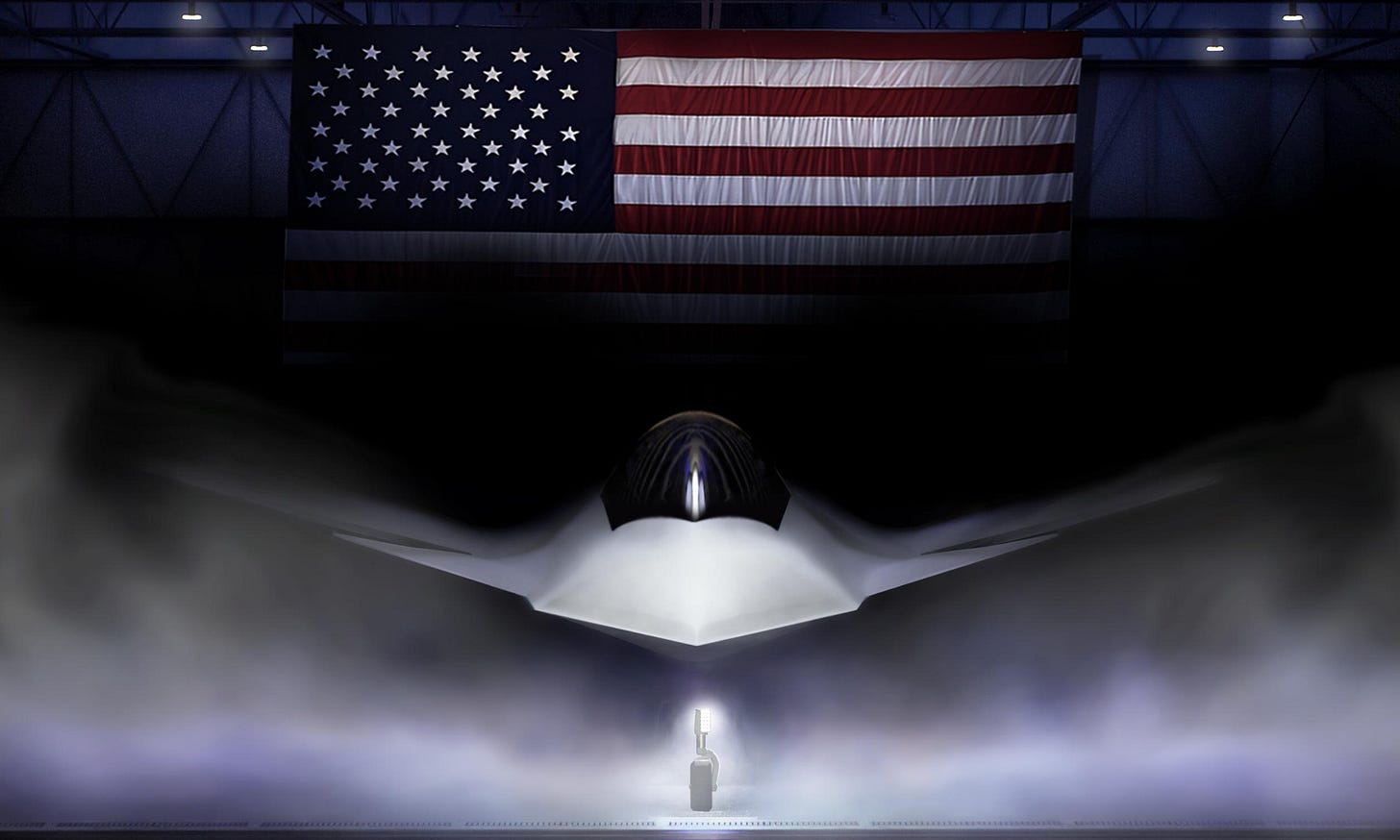NGAD's manufacturer was announced, and its design is...interesting.
Just like how the B-21 mirrored Northrop's earlier B-2 designs, the F-47 is an evolution from some of Boeing's earlier stealth designs
The Engineer's Perspective is a reader-supported publication. Sign and up and subscribe to see more in-depth Aerospace/Aeronautical Analysis!
Introduction:
On March 21, 2025, the U.S. government announced that Boeing's proposal for the Next Generation Air Dominance (NGAD) program had been selected, designating the new aircraft as the F-47. This sixth-generation fighter is intended to succeed the F-22 Raptor, incorporating advancements such as enhanced stealth, multi-spectral sensor fusion, resilient networked communications, and potential directed energy systems. Its adaptive cycle engine technology is expected to allow seamless transitions between high-thrust and fuel-efficient modes, extending range and endurance without compromising performance. The F-47 will also feature AI-driven subsystems for flight control, navigation, and systems management, reducing pilot workload and enabling greater focus on mission execution and integration of intelligence, surveillance, and reconnaissance (ISR) assets.
This selection signifies a strategic shift from platform-centric to system-centric warfare, emphasizing seamless data integration and operational adaptability in multi-domain operations. Boeing's unveiling highlights the culmination of extensive research into a cohesive, combat-ready architecture.
Concept art released by Boeing depicts an airframe with forward-swept canards, optimized planform alignment, and fuselage shaping, suggesting a focus on broadband stealth and sustained high-angle-of-attack performance. This design seems aimed at balancing speed/range, low observability while maximizing the potential agility/maneuverability of the system through the use of canards.
Historical Development: Boeing's Journey Toward Stealth and Air Dominance: From Bird of Prey to F-47
Boeing's journey toward the development of the F-47 was marked by a series of innovative projects that significantly advanced aerospace technology and stealth capabilities. A notable aspect of this evolution was Boeing's exploration of canard configurations—small forward wings positioned ahead of the main wings—which were integral to enhancing aircraft maneuverability and control.
1980s–1990s: The Genesis of Stealth: The YF-118G Boeing Bird of Prey
The beginnings of Boeing's stealth expertise started with the Bird of Prey. Developed in secrecy during the 1990s, this single-engine, technology demonstrator aircraft was built to test low-observable technologies and advanced aerodynamic concepts. The Bird of Prey featured a radical, tailless design with smoothly blended surfaces, eschewing traditional angular shapes in favor of organic curves to minimize radar reflections.
Key aspects of the Bird of Prey included:
Unconventional Shaping: Its unique, almost avian form was unlike any previous aircraft, designed to scatter radar waves away from the source.
Composite Construction: The aircraft utilized composite materials extensively to further reduce radar signature and weight.
"Gapless" Design: Control surfaces were seamlessly integrated into the wings, eliminating gaps and edges that could reflect radar energy.
Limited Performance, Maximum Innovation: While not intended for combat, the Bird of Prey successfully validated numerous stealth technologies that would later be incorporated into operational aircraft.
The Bird of Prey, which first flew in 1996, undertook only 38 test flights, but played a pivotal role in shaping Boeing’s understanding of stealth technology and low observable design. This program laid the foundation for future stealth initiatives, influencing not only aircraft design but also manufacturing techniques and materials science within Boeing.
1990s: McDonnell Douglas X-36
In collaboration with NASA, McDonnell Douglas (which merged with Boeing in 1997) developed the X-36 Tailless Fighter Agility Research Aircraft. This subscale prototype was designed to test the feasibility of a tailless fighter configuration, utilizing canards for pitch control and eliminating traditional tail surfaces to reduce weight and radar signature. The X-36 first flew on May 17, 1997, completing 31 successful research flights and demonstrating exceptional maneuverability and control, thereby validating the effectiveness of canard configurations in enhancing agility and stealth characteristics.
2010s: Sixth-Generation Fighter Concepts
Throughout the 2010s, Boeing conducted extensive studies on sixth-generation fighter concepts, focusing on integrating advanced technologies such as directed energy weapons, enhanced stealth, and network-centric warfare capabilities. These conceptual designs often featured canard configurations, aiming to achieve superior agility and survivability in highly contested environments. The emphasis on canards during this period reflected Boeing's commitment to exploring aerodynamic innovations that could provide tactical advantages in future air combat scenarios. The focus on the Bird of Prey at this time can also be a key influence, making the aircraft have a stealth advantage.
2010s–2020s: Next Generation Air Dominance (NGAD) and Penetrating Counter-Air (PCA)
The NGAD program, initiated in the mid-2010s, represented the U.S. Air Force’s strategic effort to develop a family of systems ensuring air superiority in future contested environments. A central component of this initiative was the Penetrating Counter-Air (PCA) concept, envisioned as a long-range, highly survivable aircraft capable of operating deep within adversary airspace to counter emerging threats. The PCA aimed to balance range, payload, survivability, and lethality to address advanced enemy air defenses and fifth-generation fighter threats. This advanced fighter concept heavily leans into Boeing’s history of stealth and aerodynamic air dominance and control to gain and maintain total control of the skies.
The NGAD program goal is to leverage cutting-edge technologies such as adaptive cycle engines, advanced stealth materials, and AI-driven systems to create a versatile and dominant air combat platform. It had been reported in 2020, at least one NGAD demonstrator had already flown, showcasing a significantly accelerated development timeline.
In March 2025, the U.S. government announced Boeing’s selection for the NGAD program, with the lead aircraft designated as the F-47. This milestone underscored Boeing’s commitment to advancing air combat capabilities and reflected decades of research and development in stealth and fighter technologies.
These advancements, culminating in the F-47 highlight the evolution of Boeing's aerospace engineering and development and show some of the history of its capability in developing the F-47. The F-47 has taken the original stealth concepts of the Bird of Prey, enhanced it with a more streamlined, more aerodynamic design and the addition of canard designs. While there is open-source argument that this implementation of Canards is less “stealthy” than non-canard designs, this strikes a powerful balance in terms of stealth and maneuverability, and potentially represents a significant breakthrough in fighter jet and stealth design capabilities that have been in development for decades.
Implications: What about them canards?
The F-47's development represents a significant milestone in aerospace engineering and military aviation. Its implications are far-reaching, particularly in the realms of air superiority, technological advancement, industrial base strengthening, and international relations. However, one of the most intriguing aspects of the F-47's design is the inclusion of canards, which has sparked considerable discussion among defense analysts and aviation enthusiasts.
Maneuverability:
The decision to incorporate canards into the F-47 design is a bold move that challenges conventional wisdom in stealth fighter design. While it has been in open-source forums and analysis argued that canards have been avoided in stealth aircraft due to their potential to increase radar cross-section (RCS), their inclusion in the F-47 suggests that Boeing has made significant advancements in stealth technology that allow for the benefits of canards without compromising the aircraft's low observability.
The implications of this design choice then are multifaceted:
Enhanced Maneuverability: Canards typically provide improved pitch control and responsiveness, potentially giving the F-47 an edge in close-range dogfights and high-G maneuvers. Some of the most maneuverable aircraft in the world are known to have canards such as the Eurofighter and Rafale.
Stealth Innovation: The inclusion of canards on a platform touted as stealthier than the F-22 implies that Boeing has developed new materials or design techniques to mitigate the RCS increase typically (whether deserved or not is a nother story) associated with canards.
Multi-Mode Capability: The canards might be designed to retract or reshape during high-threat scenarios, allowing the F-47 to adapt its configuration based on mission requirements.
Performance Trade-off: The decision to include canards suggests that the designers determined the maneuverability advantages outweigh potential stealth compromises, especially given advancements in sensor fusion and electronic warfare capabilities.
Specifications
Given the limited public information, many specifications are currently speculative, though key design features and mission roles can be inferred from official statements, concept art, and known technology trajectories:
Role: Air superiority fighter, optimized for operations in contested and denied airspace with capabilities spanning interception, strike, and ISR coordination.
Crew: Currently assumed to be a single pilot,supported by autonomous and semi-autonomous AI systems for avionics management, threat prioritization, and sensor fusion.
Length: Estimated between 65 and 75 feet, placing it between the F-22 and larger multirole strike platforms. It is expected to be larger though as it will likely need to hold larger amounts of fuel.
Wingspan: Estimated at 45 to 55 feet, featuring a blended wing-body design with forward-swept canards for improved control authority and agility.
Powerplant: Expected to utilize two adaptive cycle turbofan engines, enabling real-time switching between high-thrust and fuel-efficient modes. Likely includes full-authority digital engine control (FADEC) and integrated thermal management.
Speed: Supersonic cruise (supercruise) is likely; Mach 2+ performance is considered a baseline target.
Stealth: Very low observable (VLO) design with broadband signature reduction across radar, infrared, and electronic spectrums. Advanced surface treatments and edge alignment minimize radar returns.
Weapons: Internal weapons bays housing advanced air-to-air missiles such as the AIM-120 Advanced Medium Range Air-to-Air missile (AMRAAM), and is likely to include the forthcoming AIM-260 Joint Advanced Tactical Missile (JATM). The F-47 may potentially field air-to-ground or stand-off strike munitions depending on the context, as what happened to its predecessor the F-22. Future integration of directed energy weapons is under evaluation for the F-47, and if implemented may operate in both offensive and defensive roles.
Avionics: Full-spectrum multi-sensor fusion, cognitive electronic warfare (EW) capabilities, and secure, low-probability-of-intercept/low-probability-of-detection (LPI/LPD) communications.
Endurance: Extended operational range facilitated by adaptive engines and internal fuel capacity. Mid-air refueling capability is assumed standard.
Payload: Exact figures remain classified, but internal carriage is prioritized to preserve stealth. Configurable payload architecture is likely to allow mission tailoring. Considering that there have been consistent complaints of the F-35 and F-22’s capacity for their weapons bay, it is highly likely we’ll see a greater weapons capacity for the F-47.
Signature Management: Includes infrared signature suppression, radar-absorbing materials, and active/passive electronic deception systems.
Concept of Operations
The F-47 is a sixth-generation air superiority fighter developed under the U.S. Air Force's Next Generation Air Dominance (NGAD) program. Designed to operate effectively in contested and denied airspace, the F-47 integrates advanced stealth features, adaptive propulsion systems, and artificial intelligence (AI) to enhance mission effectiveness and pilot situational awareness.
Stakeholders: The Stake holders for the F-47 are
U.S. Air Force (primary operator)
Boeing (prime contractor)
Defense subcontractors specializing in avionics, propulsion, stealth technologies, and AI systems
Allied air forces (potential partners in joint operations)
Purpose:
Achieve and maintain air superiority in contested environments
Potential: Suppress or destroy enemy air defenses (SEAD/DEAD)
Conduct intelligence, surveillance, and reconnaissance (ISR) missions
Potential: Execute long-range precision strikes
Coordinate manned-unmanned teaming (MUM-T) with autonomous systems and collaborative combat aircraft (CCA)
Operational Overview:
Pre-Flight Operations:
Mission Planning: Utilize AI-driven systems to assess real-time threats and develop optimized flight routes.
Weapons Loading: Equip internal weapons bays to maintain stealth profiles.
System Diagnostics: Conduct comprehensive checks on avionics, propulsion, stealth coatings, and electronic warfare systems.
Briefings: Finalize engagement rules and communication protocols with mission planners.
Flight Operations:
Ingress: Penetrate contested airspace employing stealth capabilities, electronic countermeasures, and terrain masking techniques.
Engagement: Detect and engage targets using advanced sensor fusion and AI-assisted decision-making, allowing the pilot to focus on mission execution and strategic planning.
Manned-Unmanned Teaming: Act as a command node for CCAs, coordinating autonomous assets to enhance mission effectiveness.
Cognitive Workload Shift: Automation, driven by AI and based in part on technologies developed for CCAs, is expected to assume a larger share of basic flight control, navigation, and environmental management tasks. As a result, the pilot will increasingly take on a role resembling that of a traditional weapons systems officer (WSO), focusing on tactical execution, multi-domain coordination, and real-time resource management while benefiting from elevated situational awareness.
Post-Flight Operations:
Data Offload: Transfer mission data for debriefing and performance analysis.
Maintenance: Perform AI-assisted diagnostics to identify and address maintenance needs, ensuring readiness for subsequent missions.
Debriefing: Review mission outcomes to inform future operations and tactics.
Key Capabilities:
All-Aspect Stealth Performance Better Than Fifth-Generation Baselines
Advanced Sensor Fusion
Networked Combat Capabilities
Potential for Directed Energy Weapons
Adaptive Cycle Engines for Mission Flexibility
AI-Augmented Cockpit and Automation Support
Systems Engineering
This systems engineering overview is for the F-47 sixth-generation air superiority fighter. It addresses the foundational systems engineering approach used to define, develop, and evaluate the aircraft, focusing on core objectives, operational requirements, and lifecycle challenges. This high-level overview is not exhaustive but provides insight into the practices and considerations guiding the F-47’s engineering process.
Based on the provided information, here are the top 3-4 bullets for each major topic related to the Boeing F-47:
System Objectives
Primary Functions:
Establish air superiority in contested environments
Execute long-range interdiction and precision strikes
Operate as a command node for autonomous and manned-unmanned teaming
Key Operational Capabilities:
All-aspect stealth superior to fifth-generation platforms
Adaptive cycle propulsion for extended range and thrust modulation
AI-driven flight control and systems management
Advanced sensor fusion and electronic warfare support
Operating Conditions
Environmental Parameters:
Function across polar to desert climates, high altitude operations, and maritime conditions
Operational Constraints:
Capable of forward deployment with minimal infrastructure
Maintain performance in contested electromagnetic environments
Infrastructure Requirements:
Requires secure data links, hardened satellite comms, and AI-enabled maintenance diagnostics
Compatible with existing USAF logistics and air refueling networks
Expected Opposition/Challenges
Potential Threats/Competitors:
Peer-state fighters (e.g., Russian Su-57, Chinese J-20 variants)
Advanced surface-to-air missile systems (e.g., S-500, HQ-9B)
EW and cyber warfare capabilities designed to disrupt stealth platforms
Countermeasures/Advantages:
Superior low observability and spectral shaping
Integrated electronic attack and deception suites
Cognitive flight systems to outpace threat response loops
Design Considerations
Modular architecture for software/hardware upgrades
Scalable systems to support future mission types
Interoperable with fifth-gen and legacy platforms
Lifecycle affordability and lean logistics
Verification and Validation
Flight testing using full-scale prototypes and surrogate platforms
High-fidelity digital twin simulations and synthetic testbeds
Wind tunnel and radar cross-section testing
Cybersecurity penetration and vulnerability assessments
Systems Engineering Requirements
Based on the Concept of Operations, the following Systems Engineering Requirements are derived:
Functional Requirements
The system shall operate in both autonomous and manned control modes.
The system shall operate effectively in denied communications environments.
The system shall integrate with airborne, space, and ground-based ISR assets.
The system shall execute target prioritization using fused sensor input.
Physical Requirements
The system shall be constructed with composite and radar-absorbent materials.
The system shall takeoff with a weight of X.
The system shall have an internal payload volume of no less than X cubic feet.
The system shall support sustained high-g flight operations up to X duration.
Environmental Requirements
The system shall operate in ambient temperatures from -X°F to +X°F.
The system shall operate at altitudes up to X feet.
The system shall meet electromagnetic compatibility standards per MIL-STD-X.
Maintenance Requirements
The system shall require no more than X hours of maintenance per flight hour.
The system shall support condition-based maintenance using onboard diagnostics.
The system shall enable component replacement with minimal specialized tools.
The system shall store spare parts in modular, field-ready containers.
Interface Requirements
The system shall provide a pilot interface with adaptive visual overlays.
The system shall interface with C2ISR networks over encrypted LPI/LPD channels.
The system shall support open-architecture mission system integration.
The system shall connect to ground support systems via standardized interfaces.
Safety and Reliability Requirements
The system shall meet airworthiness certification standards under MIL-HDBK-X.
The system shall achieve a mean time between failure (MTBF) of X hours.
The system shall incorporate redundant critical subsystems (flight, power, data).
The system shall identify and isolate failure modes using onboard diagnostics.
Design Considerations
The system shall operate with modularity, allowing for exchange and maintenance of systems
The system shall be scalable, allowing for future growth and upgrading of systems via modularity
The system shal operate in conjunction with existing systems
Verification and Validation
Define flight test milestones for key mission performance benchmarks
Use simulation environments to evaluate edge-case scenarios
Specify criteria for software certification and avionics integration
Include cybersecurity red team evaluations before IOC declaration
Conclusion
The F-47 represents a transformative leap in U.S. air combat capability, reflecting a decades-long convergence of stealth, propulsion, and AI systems into a single operational architecture. More than a successor to the F-22, it embodies a strategic evolution toward system-centric warfare, where aircraft function not as isolated platforms but as integrated nodes within a broader information and effects network.
Drawing from a rich lineage of experimental aircraft and conceptual studies—including the X-36 and multiple sixth-generation research programs—the F-47 carries forward Boeing’s tradition of technological risk-taking and innovation. Its design principles emphasize survivability, adaptability, and command integration in an era marked by contested airspaces, anti-access/area denial systems, and rapid technological escalation.
The implications extend beyond hardware. The F-47 is poised to redefine the role of the human operator, leveraging automation and sensor fusion to enable pilots to act as high-level mission commanders rather than hands-on aviators. This shift, combined with its anticipated performance envelope, gives the F-47 the potential to shape doctrine, deterrence strategy, and coalition interoperability for decades to come.
Whether its full capabilities are eventually made public or remain within the classified domain, the F-47 marks a definitive moment in the trajectory of American airpower—where air dominance is no longer just about flight performance, but about data fusion, cognitive decision-making, and operational resilience in a rapidly evolving battlespace.
References
Boeing Gets Lifeline in Pentagon Deal to Build Most Expensive Jet Fighter Ever, The Wall Street Journal, March 21, 2025.
Trump's F-47 Decision Is Upsetting Lockheed's Dominance in the Stealth Fighter Game, Business Insider, March 21, 2025.
First US Sixth-Gen Fighter Jet Will Be the F-47, Trump Says, and Boeing, Not Lockheed, Is Going to Build It, Business Insider, March 21, 2025.
Eyeing China Threat, Trump Announces Boeing Wins Contract for Secretive Future Fighter Jet, Associated Press, March 21, 2025.
Trump Picks Boeing to Build Next-Generation Fighter Plane, Politico, March 21, 2025.
Boeing Wins Contract for NGAD Fighter Jet, Dubbed F-47, Defense News, March 21, 2025.
X-36 Tailless Fighter Agility Research Aircraft, NASA, November 2003.
McDonnell Douglas X-36, Wikipedia, March 21, 2025.
Air Force Awards Contract for Next Generation Air Dominance (NGAD) Platform, F-47, U.S. Air Force, March 21, 2025.
Trump Says Boeing Will Build the New Generation of Fighter Jets, the F-47, NPR, March 22, 2025.
Trump Picks Boeing Over Lockheed for Fighter Jet Contract, Reuters, March 21, 2025.
Boeing Wins Air Force Contract for NGAD Next-Gen Fighter, Dubbed F-47, Breaking Defense, March 21, 2025.
Boeing Wins F-47 Next Generation Air Dominance Fighter Contract, The War Zone, March 21, 2025.
Everything We Know About The Boeing F-47 NGAD, The Aviationist, March 22, 2025.
Boeing F-47, Wikipedia, March 24, 2025.
The Engineer's Perspective is a reader-supported publication. To receive new posts and support my work, consider becoming a free or paid subscriber.



